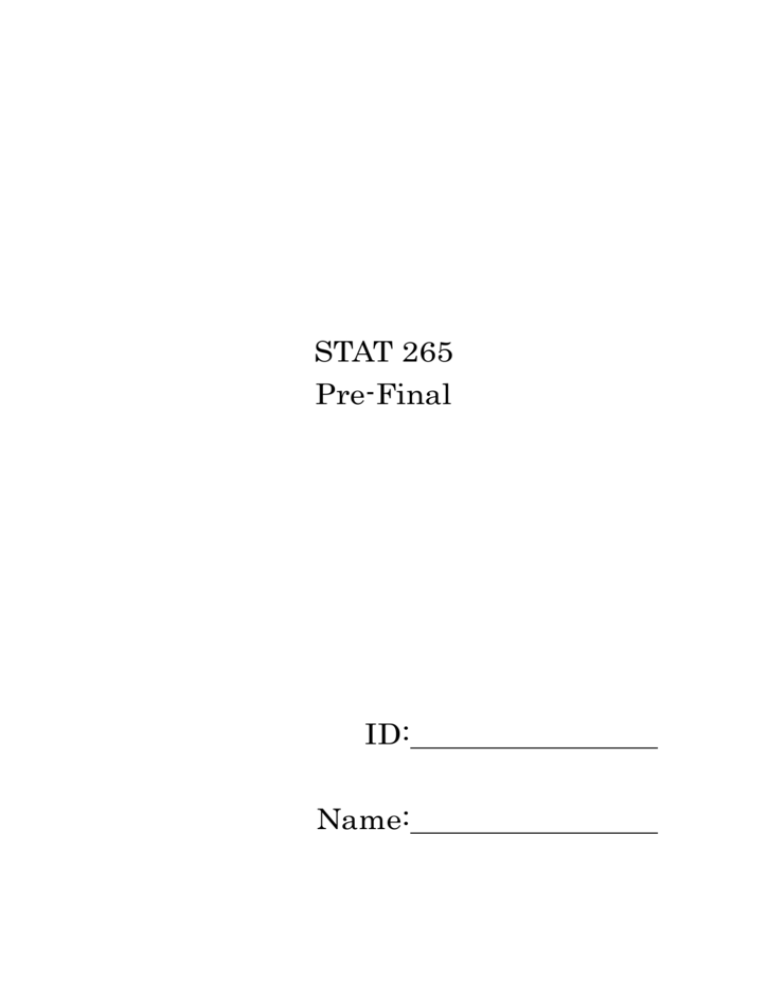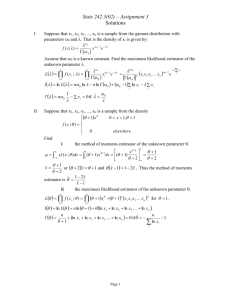STAT 265 Pre-Final ID: Name: Let be a random sample of a
advertisement

STAT 265
Pre-Final
ID:
Name:
1. Let 𝑌1 , 𝑌2 , … , 𝑌𝑛 be a random sample of a binomial distribution with n trials and
success probability p.
1
a. Show 𝑌̅ = 𝑛 ∑𝑛𝑖=1 𝑌𝑖 is a biased estimator of p
b. Show
𝑌𝑖
𝑛
is a consistent estimator of p
Hint:
𝐸(𝑌1 ) = 𝐸(𝑌2) = ⋯ = 𝐸(𝑌𝑛 ) = 𝑛𝑝, 𝑉(𝑌1 ) = 𝑉(𝑌2 ) = ⋯ = 𝑉(𝑌𝑛 ) = 𝑛𝑝(1 − 𝑝)
𝑉(𝑎𝑌) = 𝑎2 𝑉(𝑌)
For part (b),
Use the theorem:
If 𝜃̂𝑛 is an unbiased estimator for θ and lim 𝑉(𝜃̂𝑛 ) = 0, 𝜃̂𝑛 is a consistent estimator of
𝑛→∞
θ.
This means you need to show two things
-
𝑌𝑖
𝑛
is an unbiased estimator
𝑌
lim 𝑉 ( 𝑖 ) = 0
𝑛
𝑛→∞
2. Let 𝜃̂1 , 𝜃̂2 be unbiased estimator for a parameter θ where
E(𝜃̂1 ) = 𝐸(𝜃̂2 ) = 𝜃, 𝑎𝑛𝑑 𝑉(𝜃̂1 ) = 𝜎12 , 𝑉(𝜃̂2) = 𝜎22
Consider another estimator 𝜃̂3 = 𝑎𝜃̂1 + (1 − 𝑎)𝜃̂2 , 𝑎 ∈ ℝ.
a. Show 𝜃̂3 is an unbiased estimator for θ
b. Suppose 𝜃̂1 , 𝜃̂2 are independent. Find the variance of 𝜃̂3 , 𝑉(𝜃̂3). What the value of a
minimize 𝑉(𝜃̂3 )? Show your all work.
Hint:
For par b,
𝜃̂1 , 𝜃̂2 are independent ⇒ 𝐸(𝜃̂1 𝜃̂2 ) − E(𝜃̂1 )𝐸(𝜃̂2) = 𝐸(𝜃̂1 𝜃̂2 ) − 𝜃 2 = 0
f ’’(x)>0 for any x, f(x) is convex.
If f(x) is convex, f(x) will be minimized when f ’(x)=0
3. Suppose Y1 , Y2 , Y3 are independent random variables which follow the uniform
distribution, U(0, θ).
𝐸(𝑌1 ) = 𝐸(𝑌2 ) = 𝐸(𝑌3 ) =
𝜃
,
2
𝑉(𝑌1 ) = 𝑉(𝑌2 ) = 𝑉(𝑌3 ) =
𝜃2
12
Consider the estimators of θ:
𝜃̂1 = 𝑌1 ,
𝜃̂2 =
𝑌1 + 2𝑌2
,
3
𝜃̂3 = 𝑌̅ =
𝑌1 + 𝑌2 + 𝑌3
3
a. Find the variances of 𝜃̂1 , 𝜃̂2 , 𝜃̂3
b. Find the efficiency of 𝜃̂2 relative to 𝜃̂3
Hint:
If X, Y are independent and a, b are constant, V(aX+bY)=a2 V(X)+b2 V(Y)
Efficiency of 𝜃̂2 relative to 𝜃̂3 is given by
𝑉(𝜃̂3 )
𝑉(𝜃̂2 )
4. Let 𝑌1 , 𝑌2 , … , 𝑌𝑛 denote a random sample from the probability density function
given by
(𝜃 + 3)𝑦 𝜃 , 0 < 𝑦 < 1; 𝜃 > −3
𝑓(𝑦|𝜃) = {
0,
𝑒𝑙𝑠𝑒𝑤ℎ𝑒𝑟𝑒
a. Find an estimator for θ by the method of moments.
b. Find an estimator for θ by the method of maximum-likelihood.
Show your all work.
Hints:
For the part b,
L(θ) is maximized when ln[L(θ)] is maximized with the derivative dln[L(θ)]/dθ=0
5. Extra Question (you would gain extra marks if you get the correct answers)
Population is normally distributed with unknown μandσ=1. Let 𝑌̅ represent a
sample of size n. The sampling distribution with n=9 has the probability that the
sample mean will be within 0.3 of μ, P(|𝑌̅ − 𝜇| ≤ 0.3) = 0.6318. Show your work.
a. If n=16, what isP(|𝑌̅ − 𝜇| ≤ 0.3)?
b. What is P(|𝑌̅ − 𝜇| ≤ 0.3), if n=25, 36?
Hint:
For sampling distribution, z =
𝑌̅−𝜇
𝜎/√𝑛
𝑌̅−𝜇
= √𝑛 (
𝜎
)
−0.3√𝑛
𝑌̅ − 𝜇
0.3√𝑛
−0.3√𝑛
0.3√𝑛
P(|𝑌̅ − μ| ≤ 0.3) = P (
≤ √𝑛 (
)≤
) = P(
≤𝑍≤
)
𝜎
𝜎
𝜎
𝜎
𝜎
P(−0.9 ≤ Z ≤ 0.9) = 0.6318
P(−1.2 ≤ Z ≤ 1.2) = 0.7699
P(−1.5 ≤ Z ≤ 1.5) = 0.8664
P(−1.8 ≤ Z ≤ 1.8) = 0.9281
1. Solutions
1
1
1
a. 𝐸(𝑌̅) = 𝐸 (𝑛 ∑ 𝑌𝑖 ) = 𝑛 [𝐸(𝑌1 ) + ⋯ + 𝐸(𝑌𝑛 )] = 𝑛 ∙ 𝑛(𝑛𝑝) = 𝑛𝑝, so a biased estimator
𝑌
1
1
b. 𝐸 ( 𝑛𝑖 ) = 𝑛 𝐸(𝑌𝑖 ) = 𝑛 ∙ 𝑛𝑝 = 𝑝, so an unbiased estimator
𝑌𝑖
1
1
𝑝(1 − 𝑝)
𝑉 ( ) = 2 𝑉(𝑌𝑖 ) = 2 ∙ 𝑛𝑝(1 − 𝑝) =
→ 0 as 𝑛 → ∞
𝑛
𝑛
𝑛
𝑛
2. Solutions:
a. 𝐸(𝜃̂3) = 𝐸(𝑎𝜃̂1 + (1 − 𝑎)𝜃̂2 ) = 𝑎𝐸(𝜃̂1 ) + (1 − 𝑎)𝐸(𝜃̂2 ) = 𝑎𝜃 + (1 − 𝑎)𝜃 = 𝜃
2
b. 𝑉(𝜃̂3 ) = 𝐸(𝜃̂32 ) − [𝐸(𝜃̂3 )]
= 𝐸(𝑎2 𝜃̂12 + 2𝑎(1 − 𝑎)𝜃̂1 𝜃̂2 + (1 − 𝑎)2 𝜃̂22 ) − 𝜃 2
= 𝑎2 𝐸(𝜃̂12 ) + 2𝑎(1 − 𝑎)𝐸(𝜃̂1 𝜃̂2 ) + (1 − 𝑎)2 𝐸(𝜃̂22) − 𝜃 2
+2𝑎(1 − 𝑎)𝜃 2 − 2𝑎(1 − 𝑎)𝜃 2
2
2
= 𝑎2 (𝑉(𝜃̂1 ) + (𝐸(𝜃̂1)) ) + (1 − 𝑎)2 (𝑉(𝜃̂2 ) + (𝐸(𝜃̂2)) )
⏟
⏟
̂ 2)
𝐸(𝜃
1
̂2)
𝐸(𝜃
2
2
2
+2𝑎(1 − 𝑎) [𝐸(𝜃
⏟ ̂1 𝜃̂2 ) − 𝜃 ] − 𝜃 (1 − 2𝑎(1 − 𝑎))
0
= 𝑎2 (𝜎12 + 𝜃 2 ) + (1 − 𝑎)2 (𝜎22 + 𝜃 2 ) − (2𝑎2 − 2𝑎 + 1)𝜃 2
= 𝑎2 [(𝜎12 + 𝜃 2 ) + (𝜎22 + 𝜃 2 ) − 2𝜃 2 ] + 𝑎[−2(𝜎22 + 𝜃 2 ) + 2𝜃 2 ] + [(𝜎22 + 𝜃 2 ) − 𝜃 2]
= 𝑎2 (𝜎12 + 𝜎22 ) − (2𝜎22 )𝑎 + 𝜎22
Consider 𝑓(𝑎) = 𝑎2 (𝜎12 + 𝜎22 ) − (2𝜎22 )𝑎 + 𝜎22 . Since (𝜎12 + 𝜎22 ) > 0, this is convex.
𝑓(𝑎) will be minimized when 𝑓′(𝑎) = 0.
𝑓 ′ (𝑎) = 2(𝜎12 + 𝜎22 )𝑎 − 2𝜎22 = 0
𝑎=
𝜎22
2
𝜎1 +𝜎22
3. Solutions
2
𝜃
a. 𝑉(𝜃̂1 ) = 𝑉(𝑌1 ) = 12
𝑌1 + 2𝑌2
1 2
2 2
5 𝜃2
𝑉(𝜃̂2 ) = 𝑉 (
) = ( ) 𝑉(𝑌1 ) + ( ) 𝑉(𝑌2 ) = ( )
3
3
3
9 12
𝑌1 + 𝑌2 + 𝑌3
1 2
1 2
1 2
3 𝜃2
𝑉(𝜃̂3 ) = 𝑉 (
) = ( ) 𝑉(𝑌1 ) + ( ) 𝑉(𝑌2 ) + ( ) 𝑉(𝑌3 ) = ( )
3
3
3
3
9 12
b.
̂3 )
𝑉(𝜃
̂2 )
𝑉(𝜃
=
3 𝜃2
( )
9 12
5 𝜃2
(
9 12
)
=
3
5
4. a.
1
𝐸(𝑌) = 𝐸(𝐸(𝑌|𝜃)) = ∫ 𝑦𝑓(𝑦|𝜃)𝑑𝑦
=
0
1
∫0 (𝜃
+ 3)𝑦 𝜃+1 𝑑𝑦
𝜃+3
𝜃+3
= (𝜃+2) 𝑦 (𝜃+2) |10 = (𝜃+2) = 𝜇
Solve by θ, θ =
2𝜇−3
1−𝜇
The method-of-moments estimator is
2𝑌−3
1−𝑌
b.
𝐿(𝜃) = 𝑓(𝑦1 |𝜃) × ⋯ × 𝑓(𝑦𝑛 |𝜃)
= (θ + 3)𝑦1𝜃 × ⋯ × (𝜃 + 3)𝑦𝑛𝜃
= (𝜃 + 3)𝑛 (𝑦1 ⋯ 𝑦𝑛 )𝜃
𝑛
ln[𝐿(𝜃)] = 𝑛 ln(𝜃 + 3) + 𝜃 ∑
ln 𝑦𝑖
𝑖=1
𝑛
𝑑 ln[𝐿(𝜃)]
𝑛
=
+ ∑ ln 𝑦𝑖 = 0
𝑑𝜃
𝜃+3
𝑖=1
Solve by θ,
𝜃̂ =
−𝑛
∑𝑛𝑖=1 ln 𝑦𝑖
−3
The Maximum-likelihood estimator is
−𝑛
∑𝑛
𝑖=1 ln 𝑌𝑖
−3
5. Solutions:
a. P(| – μ| ≤ .3) = P(–1.2 ≤ Z ≤ 1.2) = .7699.
b. P(| – μ| ≤ .3) = P(–.3 ≤ Z ≤ .3 ) = 1 – 2P(Z > .3 ). For n = 25, 36, the
probabilities are (respectively) 0.8664, 0.9281.









